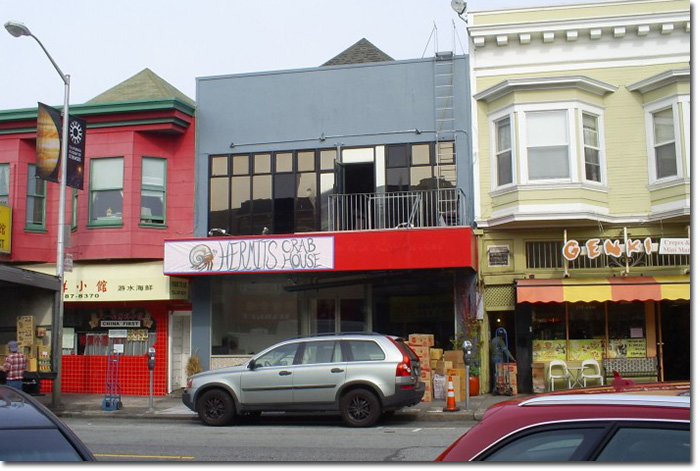Asian (con)fusion
« previous post | next post »
Michael Robinson sent in the following photograph of a restaurant which I believe is in the Inner Richmond section of San Francisco:
During the last few weeks, we've experienced a lot of befuddlement over just what animal symbolizes the lunar New Year — see: "Year of the ovicaprid" (2/15/15).
I feel the same sense of bewilderment over just what kind of restaurant this one is. Online listings describe it as serving teppanyaki, teriyaki, tempura, and other Japanese dishes, and they advertise themselves as being a "Japanese restaurant".
It looks as though the English name of the restaurant is "Chow in" (as opposed to "take out"?), but there's a missing "W" at the front of "in", so it is the "Chow Win Restaurant". That matches the Chinese name, which (in Mandarin pronunciation) is:
Cháoróng hǎixiān jiǔlóu 潮榮海鮮酒樓 ("Chaorong Seafood Restaurant")
I may be wrong about this, but "Chow Win" has a Cantonese ring to it, and may refer to Chaozhou ("Glory of Chaozhou"), an important city in Guangdong (Canton) Province, where they actually speak Teochew, a Southern Min topolect.
As for why the same term, jiǔlóu 酒樓 (lit., "brew / ale tower") can mean both "restaurant" and "hotel"), see "Coarse grains hotel" (6/1/14), which has links to other posts that discuss Chinese words for eating establishments.
Another photograph of the same restaurant, also on flickr, shows a truck parked out front that appears to be moving kitchen equipment.
As of February 5, 2015, just two weeks ago, the establishment at the same location has been changed to Hermit's Crab House:
The sign looks as though it were hastily put up and, although it is cleverly designed, seems to be temporary in nature. The boxes piled up on the sidewalk in front of the store make me think that, when the photograph was taken, they were still moving in.
If you have an inclination to dine at 332 Clement St. in Jiùjīnshān 旧金山 ("Old Gold Mountain", i.e., Sānfānshì 三藩市, aka Shèng Fúlǎngxīsīkē 聖弗朗西斯科), you'd better hurry up before it changes into something else.

julie lee said,
February 20, 2015 @ 11:01 pm
In your post above you mention "Chaozhou…, an important city in Guangdong (Canton) Province, where they actually speak Teochew, a Southern Min topolect".
I might mention that "Teochew" is the Fukienese (Fujian topolect) pronunciation of "Chaozhou(潮州)". Chouzhou is the Mandarin pronunciation of 潮州。 “Min (閩)" is another name for Fukien (Fujian) province.
When I was a schoolgirl in Singapore, many of my Chinese schoolmates were surnamed Tan. I didn't realize until years later that Tan was simply the Teochew pronunciation of (Mandarin) Chen 陳.
julie lee said,
February 20, 2015 @ 11:15 pm
Also, in your post, you note that "in" in "Chow in Restaurant" stands for Chow Wing Restaurant, and that Wing was probably Cantonese for 榮 "glory"(in the sign), pronounced Rong in Mandarin.
I might mention that in my family's Hupei (Hubei) topolect, this 榮 "glory" ("wing" in Cantonese, "rong" in Mandarin) is pronounced "ywing".
Jeffrey Willson said,
February 25, 2015 @ 6:41 am
Isn't it more likely that 潮 chao just refers to "tide/current", so that the restaurant name means "Glory of the Waves Seafood Restaurant"?
Victor Mair said,
February 25, 2015 @ 9:21 am
Chaozhou got its name (in 591) because it is famous for its tides. I had originally mentioned this in my post, but took it out because I didn't want to complicate matters.
See here and here, and there are many other places on the web where you can find this information.
http://www.chinalanguage.com/forums/viewtopic.php?f=6&t=1472#p7274
http://en.wikipedia.org/wiki/Chaozhou
http://en.wikipedia.org/wiki/Teochew_people
http://www.britannica.com/EBchecked/topic/105941/Chaozhou
As to whether the name of the restaurant refers to the city, tides, or both, you'd have to ask the owners, if you can find them.
Jeffrey Willson said,
February 26, 2015 @ 9:41 pm
I asked my usual informant (the mother of my beautiful daughter) about this name, and she could not confirm whether 潮 refers to 潮州, but she said that the name 酒樓 was a dead giveaway that it was Cantonese food.
Chas Belov said,
February 27, 2015 @ 5:10 am
As for the Japanese menu, that's no mystery. There's been a trend for at least the past ten years for marginal Chinese restaurants in San Francisco to add a Japanese menu. This is the first case, though, that I've heard of an apparent complete replacement.